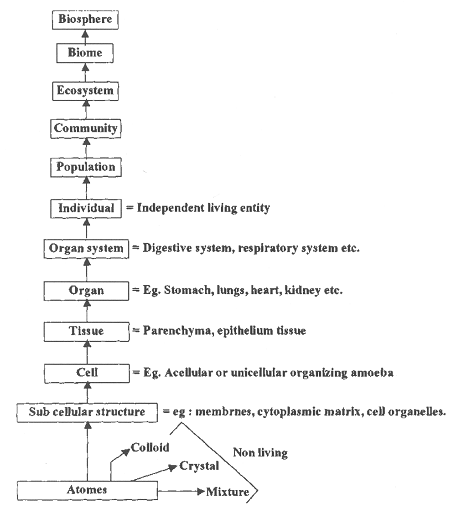UNDERSTANDING LIFE -
- Presence of protoplasm is the important feature of life which acts the site of metabolism.
- Maintenance of life by protoplasm requires continuous energy conversion and using energy for performance of certain vital activities.
- Protoplasm is made up of inorganic (81% - water 80% + minerals & gases 1%) & organic matter (19% - protein 14% + lipid 3% + carbohydrate 1% + regulatory substances as enzymes, hormones, vitamins & nucleic acid 1%)
- Inorganics are always micro biomolecules.
- Organics may be micro or macro biomolecules.
- C, H, O, N, P, S form about 98% of body weight of organism.
- O element is maximum i.e. 62%.
- Thus life can be defined as "the ever active and changeable state of organized matter".
- A living being act as an organisation so they are called organism.
- Living organism are morphous.
These are main characters of living beings -
1. ORGANISATION -
(i) Protoplasmic level - e.g. Protozoa
(ii) Cellular level - e.g. Porifera
(iii) Tissue level - e.g. Coelenterata, Ctenophora
(iv) Organ system level - e.g. Platyhelminthes to Mammals
- These levels beyond the individual organism are -
(i) Population level - All individuals of a species in a particular area.
(ii) Community level - Population of different species as plants or animals present in a particular area.
(iii) Ecosystem - Living beings inter act with non-living components.
(iv) Biosphere lelvel - Different ecosystem of all the geographical regions of the world form the biosphere.
- Factor regulating the organisation -
(i) Aggregation - It involves grouping of smaller units to form large units.
(ii) Interaction - It involves interrelationship between different components of an aggregate.
(iii) Equilibrium - Tendency to keep a balance or stability e.g. to maintain ecological balance in nature.
(iv) Change - It is ability to show variation as different atoms as C, H, O, N, combine in different ways to form different chemical in body.
